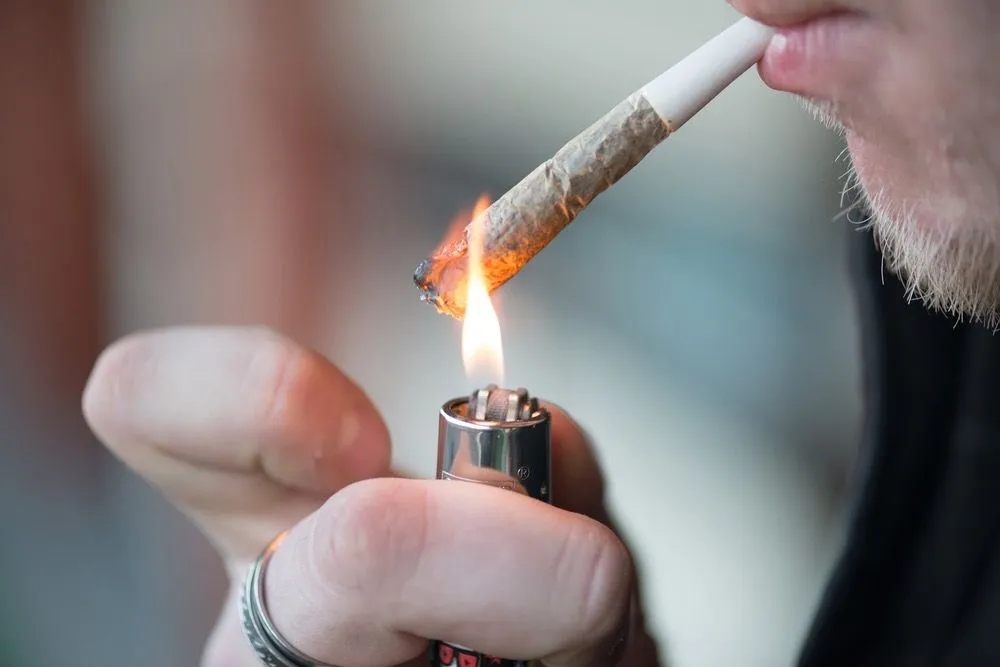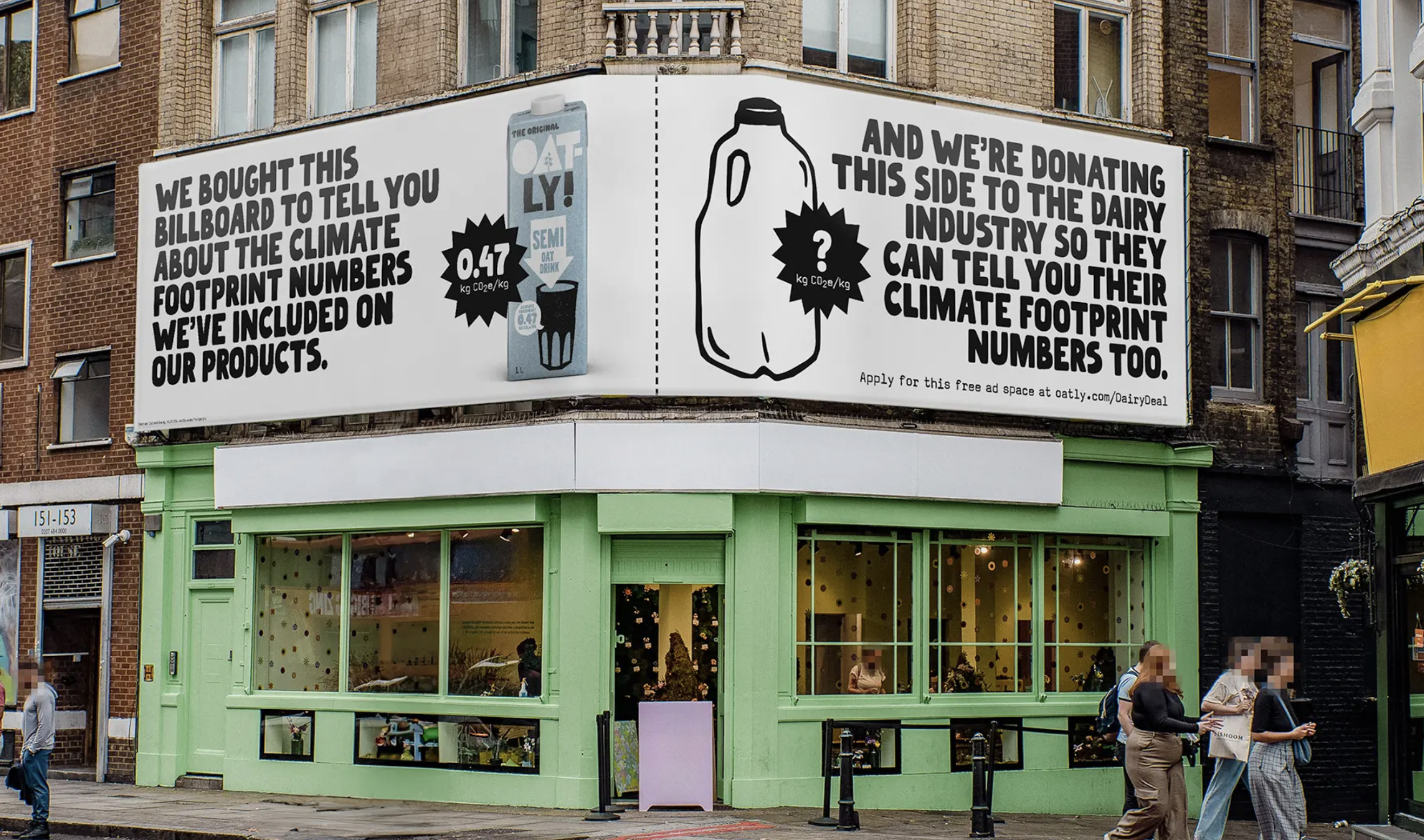PUBLISHED
May 30, 2024
WORDS
Esme Smith
The Next Revolution is… Spliff Justice
The era of the anonymous “baggy of weed” is gradually receding, replaced by a blossoming world of packaging, innovation and branding. Cannabis companies are turning to purpose to drive differentiation in a crowded marketplace and create meaningful impact. From dog treats to seltzers, hemp-based plastic to menstrual care, cannabis marketing is finding its panacea.
A recent spate of legalisations and increased cultural acceptance is driving a boom in the cannabis industry, with global sales projected to reach $55 billion by 2027. According to the Pew Research Center, 62% of Americans – including majorities of Millennials (74%), Gen-Xers (63%) and Baby Boomers (54% ) – think cannabis should be legal.
Brands are successfully reaching a fast growing, diversifying audience by investing in product innovation and moving beyond the plant’s bud.
About a decade ago, approximately 80% of all product sales were attributed to the bud; now, that number is 47%. Increasingly, consumers are attracted to edibles, infused products and other manufactured cannabis goods. Innovation and storytelling is now centred around specific plant components, like hemp (the fibrous part left over from cultivation), CBD (the part that relaxes you) or THC (the part that gets you high).
The rise of lower dose, tasty products that you don’t have to smoke is attracting new audiences. When the world’s largest distributor of weed, Curaleaf, launched an infused seltzer in Massachusetts 50% of product sales came from consumers who were totally new to cannabis.
Curaleaf imagines that their infused seltzers could even replace that glass of wine at the end of a long day. Just as relaxing but no hangover, as recommended by Bon Appétit and Esquire in their top “happy hour high” lists. Products such as these easily integrate into everyday life.
But there is a problem. Yes, the weed industry is experiencing incredible growth, especially in the USA where cannabis has been reclassified from a Class A drug to Class C at a federal level, but that growth is making mostly white men very, very wealthy. And there is a high risk of extractive monocultural farming methods given the sheer volume of land required to meet growing demand.
Thankfully, there are more and more companies popping up who are rooted in ethical and equitable practices of cultivation and distribution. Brands that recognise the power of weed to repair our communities. Repair our planet. And even repair our health.
A recent spate of legalisations and increased cultural acceptance is driving a boom in the cannabis industry, with global sales projected to reach $55 billion by 2027. According to the Pew Research Center, 62% of Americans – including majorities of Millennials (74%), Gen-Xers (63%) and Baby Boomers (54% ) – think cannabis should be legal.
Brands are successfully reaching a fast growing, diversifying audience by investing in product innovation and moving beyond the plant’s bud.
About a decade ago, approximately 80% of all product sales were attributed to the bud; now, that number is 47%. Increasingly, consumers are attracted to edibles, infused products and other manufactured cannabis goods. Innovation and storytelling is now centred around specific plant components, like hemp (the fibrous part left over from cultivation), CBD (the part that relaxes you) or THC (the part that gets you high).
The rise of lower dose, tasty products that you don’t have to smoke is attracting new audiences. When the world’s largest distributor of weed, Curaleaf, launched an infused seltzer in Massachusetts 50% of product sales came from consumers who were totally new to cannabis.
Curaleaf imagines that their infused seltzers could even replace that glass of wine at the end of a long day. Just as relaxing but no hangover, as recommended by Bon Appétit and Esquire in their top “happy hour high” lists. Products such as these easily integrate into everyday life.
But there is a problem. Yes, the weed industry is experiencing incredible growth, especially in the USA where cannabis has been reclassified from a Class A drug to Class C at a federal level, but that growth is making mostly white men very, very wealthy. And there is a high risk of extractive monocultural farming methods given the sheer volume of land required to meet growing demand.
Thankfully, there are more and more companies popping up who are rooted in ethical and equitable practices of cultivation and distribution. Brands that recognise the power of weed to repair our communities. Repair our planet. And even repair our health.

Healing the planet
The global legal cannabis market is projected to grow at a compound annual growth rate of more than 25% between now and 2030. It will need a lot of farmland.
Brands will have to think about how to grow and manufacture sustainably in a way that support biodiversity if we want to avoid the damage caused by industrial agriculture.
Sun+Earth is a nonprofit, third-party certification for regenerative organic cannabis that launched nearly five years ago in California. So far it has certified more than 60 farms. Sun+Earth will not certify crops grown with chemical fertilizers or pesticides; instead, the nonprofit’s standards encourage farmers to plant cannabis alongside food crops, use cover crops, compost and reduce soil tillage. It ensures its workers are paid fairly and ensures the farm’s neighbors and greater community are positively impacted.
Certifications such as these serve a growing need for transparent sourcing strategies demanded by consumers. They want to know where their products come from and the environmental and social trail they leave behind.
The growing popularity of weeds provides an opportunity for small scale farmers struggling with declining profitability from traditional crops to not only diversify their offering, but enrich the land beneath them.
Hemp is great for the soil. It’s a bioaccumulator, meaning it can clean up contaminated soil by absorbing toxins. It requires fewer pesticides and less water. Hemp can also be used to produce biodegradable plastics, which could be an alternative to traditional plastics.
Brands will have to think about how to grow and manufacture sustainably in a way that support biodiversity if we want to avoid the damage caused by industrial agriculture.
Sun+Earth is a nonprofit, third-party certification for regenerative organic cannabis that launched nearly five years ago in California. So far it has certified more than 60 farms. Sun+Earth will not certify crops grown with chemical fertilizers or pesticides; instead, the nonprofit’s standards encourage farmers to plant cannabis alongside food crops, use cover crops, compost and reduce soil tillage. It ensures its workers are paid fairly and ensures the farm’s neighbors and greater community are positively impacted.
Certifications such as these serve a growing need for transparent sourcing strategies demanded by consumers. They want to know where their products come from and the environmental and social trail they leave behind.
The growing popularity of weeds provides an opportunity for small scale farmers struggling with declining profitability from traditional crops to not only diversify their offering, but enrich the land beneath them.
Hemp is great for the soil. It’s a bioaccumulator, meaning it can clean up contaminated soil by absorbing toxins. It requires fewer pesticides and less water. Hemp can also be used to produce biodegradable plastics, which could be an alternative to traditional plastics.
Healing communities
The history of cannabis is marred by bias, discrimination and extreme injustice experienced by minority communities.
“The cannabis industry is one of the only industries I can think of in the 20th century that was actually built by Black and Brown people—as owners and operators, not only as laborers—in the informal market, and has been stolen in the formal market by white corporations,” says founder of The People’s Ecosystem, Christine De La Rosa.
The inequity within the growth of the weed industry is already apparent. New businesses are cropping up, from dispensaries to cultivation centers, creating a slew of job opportunities in agriculture, retail, and healthcare. But currently fewer than 5% of cannabis companies in the US are Black owned.
Housing Works Cannabis exists to diversify those who reap the rewards of the growing industry. It promotes cannabis products from LGBTQ+, BIPOC, and women-led brands, as these communities have been disproportionately affected by drug criminalisation.
Marketers now play an important role in not only rectifying years of misinformation and stigma, but actively creating a world where cannabis equitably benefits all communities, especially those persecuted by the war on drugs.
“The cannabis industry is one of the only industries I can think of in the 20th century that was actually built by Black and Brown people—as owners and operators, not only as laborers—in the informal market, and has been stolen in the formal market by white corporations,” says founder of The People’s Ecosystem, Christine De La Rosa.
The inequity within the growth of the weed industry is already apparent. New businesses are cropping up, from dispensaries to cultivation centers, creating a slew of job opportunities in agriculture, retail, and healthcare. But currently fewer than 5% of cannabis companies in the US are Black owned.
Housing Works Cannabis exists to diversify those who reap the rewards of the growing industry. It promotes cannabis products from LGBTQ+, BIPOC, and women-led brands, as these communities have been disproportionately affected by drug criminalisation.
Marketers now play an important role in not only rectifying years of misinformation and stigma, but actively creating a world where cannabis equitably benefits all communities, especially those persecuted by the war on drugs.
Healing our minds and bodies
Cannabis has long been hailed for its medicinal properties. From alleviating chronic pain to reducing anxiety and helping with sleep disorders. In 2018 the UK legalised medical use of cannabis. The advent of medical marijuana has allowed patients to find relief from conditions that traditional pharmaceuticals may not adequately address, but it’s often hard to get.
CBD oil, on the other hand, is often available in health shops as long as it doesn’t advertise medical benefits, making it the gateway for brands nervous to invest in a substance still illegal in much of the world.
Gossamer is a German lifestyle brand that creates cannabis-centered content, covering everything from travel to food, design, and culture. They also sell a line of products such as Dusk, a cannabis-based sleep aid to cater for the modern wellness orientated consumer. Rose Delights is another wellness brand pitching daily microdoses of THC for overall wellbeing.
Rif Care makes period care out of hemp fibre. It’s focus is on providing safe menstrual solutions. Hemp fibre is used because of its natural, non-hormone disrupting qualities.
The wellbeing movement has not only helped dismantle the idle stoner stereotype but propel its use into mainstream culture.
According to one study of 2,000 American adults, 91% of adults aged 21+ who have ever consumed cannabis have done so for health and wellness purposes. 75% said they would prefer holistic solutions over pharmaceuticals to treat a medical issue when possible, with 62% of people saying they would prefer to use cannabis rather than pharmaceuticals to treat a medical issue.
For marketers, the opportunity is to speak to a bigger story of healing, leveraging the natural power of maraujana.
CBD oil, on the other hand, is often available in health shops as long as it doesn’t advertise medical benefits, making it the gateway for brands nervous to invest in a substance still illegal in much of the world.
Gossamer is a German lifestyle brand that creates cannabis-centered content, covering everything from travel to food, design, and culture. They also sell a line of products such as Dusk, a cannabis-based sleep aid to cater for the modern wellness orientated consumer. Rose Delights is another wellness brand pitching daily microdoses of THC for overall wellbeing.
Rif Care makes period care out of hemp fibre. It’s focus is on providing safe menstrual solutions. Hemp fibre is used because of its natural, non-hormone disrupting qualities.
The wellbeing movement has not only helped dismantle the idle stoner stereotype but propel its use into mainstream culture.
According to one study of 2,000 American adults, 91% of adults aged 21+ who have ever consumed cannabis have done so for health and wellness purposes. 75% said they would prefer holistic solutions over pharmaceuticals to treat a medical issue when possible, with 62% of people saying they would prefer to use cannabis rather than pharmaceuticals to treat a medical issue.
For marketers, the opportunity is to speak to a bigger story of healing, leveraging the natural power of maraujana.
The green rush is on
Major consumer brands are researching and developing products, legislation is modernising, cultural attitudes are pivoting – and marketing is at the centre.
The cannabis industry has the profound ability to create a confluence of economic, social, and political change. Cannabis businesses can—and should—do good.
As cannabis becomes more accepted, it can ride and contribute to a cultural shift towards natural wellness and sustainability. Marketers can tap into this by positioning their brands as part of a broader lifestyle movement. Weather we see ‘Spliff Justice” – sustainable and equitable brands winning out – as the industry develops or good intentions go up in smoke in a rush for green gold will depend in no small way on the power of purpose-led brands to connect and stand out.
The cannabis industry has the profound ability to create a confluence of economic, social, and political change. Cannabis businesses can—and should—do good.
As cannabis becomes more accepted, it can ride and contribute to a cultural shift towards natural wellness and sustainability. Marketers can tap into this by positioning their brands as part of a broader lifestyle movement. Weather we see ‘Spliff Justice” – sustainable and equitable brands winning out – as the industry develops or good intentions go up in smoke in a rush for green gold will depend in no small way on the power of purpose-led brands to connect and stand out.
Your Cookie Settings
By clicking 'Accept All Cookies', you agree to the storing of cookies on your device to enhance site navigation, analyse site usage, and assist in our marketing efforts.



